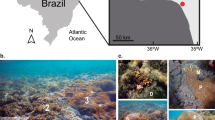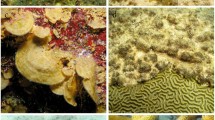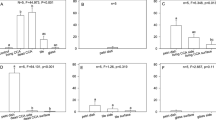Abstract
Interactions between the red algaPlocamium hamatum J. Agardh (Rhodophyta) and other benthic organisms including the alcyonacean soft coralSinularia cruciata (Tixier-Durivault) were investigated on an inshore fringing reef environment in whichP. hamatum was the dominant large fleshy alga. Field observations of sessile reef organisms including octocorals and sponges living in close proximity toP. hamatum revealed that varying degrees of tissue necrosis were suffered by the invertebrates when in physical contact with the alga. In order to establish whether the chemical constituents of the alga, especially chloromertensene, played a role in this necrosis, manipulative field experiments were carried out in the Pelorus Channel, Palm Island group (18°34′S; 146°29′E), North Queensland, Australia, in November and December 1988. The first experiment involved the relocation of healthy plants and soft corals into contact and non-contact situations on a mesh grid. In all cases of contact betweenP. hamatum andS. cruciata, the soft coral suffered tissue necrosis (n=6,p=0.0022). The second experiment had the same design, but involved the use of artificial “plants” both uncoated and coated with natural levels of chloromertensene, in contact withS. cruciata. In all cases of contact with coated treatments, necrosis was observed inS. cruciata (n=4,p=0.025). In cases where uncoated artificial fronds were placed in contact with soft corals,S. cruciata showed minor abrasion effects, but no appreciable necrosis. Coated treatments were not fouled by epiphytes during the experiment and were not consumed by predators. Uncoated treatments were rapidly reduced in size by predation and any remaining material was biofouled. These experiments thus demonstrated that the deleterious effects observed in soft corals in the field were caused by contact with the algaP. hamatum, that these effects were indeed chemically mediated by chloromertensene, and that physical contact without chemical intervention caused no such deleterious effects. This is the first experimental evidence which conclusively demonstrates allelopathy between an alga and other marine organisms and identifies the compound responsible for the observed allelopathic effects.
Similar content being viewed by others
Literature cited
Bak, R. P. M., Borsboom, J. L. A. (1984). Allelopathic interaction between a reef coelenterate and benthic algae. Oecologia 63: 194–198
Bak, R. P. M., Engel, M. S. (1979). Distribution, abundance and survival of juvenile hermatypic corals (Scleractinia) and the importance of life history strategies in the parent coral community. Mar. Biol. 54: 341–352
Bak, R. P. M., Sybesma, J., Van Duyl, F. C. (1981). The ecology of the tropical compound ascidianTrididemnum solidum. II. Abundance, growth and survival. Mar. Ecol. Prog. Ser. 6: 43–52
Benayahu, Y., Loya, Y. (1981). Competition for space among coral reef sessile organisms at Eilat. Red Sea. Bull. mar. Sci. 31: 514–522
Birkeland, C. (1977). The importance of rate of biomass accumulation in early successional stages of benthic communities to the survival of coral recruits. Proc. 3rd int. Symp. coral Reefs 1: 15–21. [Taylor, D. L. (ed.) School of Marine and Atmospheric Science, University of Miami]
Bowden, B. F., Coll, J. C., Wright, A. D. (1989). Studies of Australian soft corals. XLIV. New diterpenes fromSinularia polydactyla (Coelenterata, Anthozoa, Octocorallia). Aust. J. Chem. 42: 757–763
Carlson, D. J., Carlson, M. L. (1984). Reassessment of exudation by fucoid macroalgae. Limnol. Oceanogr. 29: 1077–1087
Coll, J. C., Price, I. R., König, G. M., Bowden, B. F. (1987). Algal overgrowth of alcyonacean soft corals. Mar. Biol. 96: 129–135
Coll, J. C., Skelton, B. W., White, A. H., Wright, A. D. (1988). Tropical marine algae. II. The structure determination of new halogenated monoterpenes fromPlocamium hamatum (Rhodophyta, Gigartinales, Plocamiaceae). Aust. J. Chem. 41: 1743–1753
Connell, J. H. (1973). Population ecology of reef building corals. In: Jones, O. A., Endean, R. (eds.) Biology and geology of coral reefs. Vol. 2. Biology 1. Academic Press, New York, p. 205–245
Conover, J. T., Sieburth, J. (1966). Effects of tannins excreted from Phaeophyta on planktonic animal survival in tide pools. Proc. 5th int. Seaweed Symp: 99–100. [Young, E. G., McLachlan, J. L. (eds.) Pergamon Press, Oxford]
Dahl, A. L. (1974). The structure and dynamics of benthic algae in the coral reef ecosystem. Proc. 2nd int. coral Reef Symp. 1: 21–25. [Cameron, A. M. et al. (eds.) Great Barrier Reef Committee, Brisbane]
Dart, J. K. G. (1972). Echinoids, algal lawn and coral recolonization. Nature, Lond. 239: 50–51
De Ruyter van Stevenick, E. D., Van Mulekom, L. L., Breeman, A. M. (1988). Growth inhibition ofLobophora variegata (Lamouroux) Womersley by scleractinian corals. J. exp. mar. Biol. Ecol. 115: 169–178
Fletcher, R. L. (1975). Heteroantagonism observed in mixed algal cultures. Nature, Lond. 253: 534–535
Fogg, G. E. (1966). The extracellular products of algae. Oceanogr. mar. Biol. A. Rev. 4: 195–212
Fox, L. R. (1981). Defense and dynamics in plant-herbivore systems. Am. Zool. 21: 853–864
Glynn, P. W. (1973). Aspects of the ecology of coral reefs in the western Atlantic region. In: Jones, O. A., Endean, R. (eds.) Biology and geology of coral reefs. Vol. 2. Biology 1. Academic Press, New York, p. 271–324
Gschwend, P. M., MacFarlane, J. K., Turner, K. A. (1985). Volatile halogenated organic compounds released to seawater from marine macroalgae. Science, N.Y. 227: 1033–1035
Harlin, M. M. (1987). Allelopathy in marine macroalgae. CRC critical Rev. Pl. Sciences 5: 237–249
Hay, M. E., Fenical, W. (1988). Marine plant-herbivore interactions: the ecology of chemical defenses. A. Rev. Ecol. Syst. 19: 111–145
Hay, M. E., Fenical, W., Gustafson, K. (1987). Chemical defenses against diverse coral-reef herbivores. Ecology 68: 1581–1591
Hellebust, J. A. (1975). Extracellular products. In: Stewart, W. D. P. (ed.) Algal physiology and biochemistry. Blackwell Scientific Publications, Oxford, 838–863
Jackson, J. B. C. (1977). Competition on marine hard substrata: the adaptive significance of solitary and colonial strategies. Am. Nat. 111: 743–767
Jackson, J. B. C., Buss, L. W. (1975). Allelopathy and spatial competition among coral reef invertebrates. Proc. natn. Acad. Sci. U.S.A. 72: 5160–5163
Khfaji, A. K., Boney, A. D. (1979). Antibiotic effect of crustose germlings of the red algaChondrus crispus Stackh. on benthic diatoms. Ann. Bot. 43: 231–232
Lewis, S. M. (1986). The role of herbivorous fishes in the organisation of a Caribbean reef community. Ecol. Monogr. 56: 183–200
Maier, I., Müller, D. G. (1986). Sexual pheromones in algae. Biol. Bull. mar. biol. Lab., Woods Hole 170: 145–175
McConnell, O. J., Hughes, P. A., Targett, N. M., Daley, J. (1982). Effects of secondary metabolites on feeding by the sea urchinLytechinus variegatus. J. chem. Ecol. 8: 1427–1453
McLachlan, J., Craigie, J. (1966). Antialgal activity of some simple phenols. J. Phycol. 2: 133–135
McNaughton, S. J., Wolf, L. L. (1979). General ecology. 2nd ed. Holt, Rinehart & Winston, New York
Paul, V. J., Fenical, W. (1985). Diterpenoid metabolites from Pacific marine algae of the order Caulerpales (Chlorophyta). Phytochem. 24: 2239–2243
Paul, V. J., Hay, M. E., Duffy, J. E., Fenical W., Gustafson, K. (1987). Chemical defense in the seaweedOchtodes secundiramea (Montagne) Howe (Rhodophyta): effects of its monoterpenoid components upon diverse coral reef herbivores. J. exp. mar. Biol. Ecol. 114: 249–260
Phillips, D. W., Towers, G. H. N. (1982). Chemical ecology of red algal bromophenols. I. Temporal, interpopulational and withinthallus measurements of lanosol levels inRhodomela larix (Turner) C. Agardh. J. exp. mar. Biol. Ecol. 58: 285–293
Porter, J. W. (1974). Community structure of coral reefs on opposite sites of the isthmus of Panama. Science, N.Y. 186: 543–545
Potts, D. C. (1977). Suppression of coral populations by filamentous algae within damselfish territories. J. exp. mar. Biol. Ecol. 28: 207–216
Rice, E. L. (1984). Allelopathy. 2nd ed. Academic Press, New York
Rosenthal, G. A., Jansen, D. H. (1979). Herbivores: their interaction with secondary plant metabolites. Academic Press, New York
Russ, G. (1984). Distribution and abundance of herbivorous grazing fishes in the Great Barrier Reef. I. Levels of variability across the entire continental shelf. Mar. Ecol. Prog. Ser. 20: 23–34
Sammarco, P. W. (1980). Diadema and its relationship to coral spat mortality: grazing, competition, and biological disturbance. J. exp. mar. Biol. Ecol. 45: 245–272
Sammarco, P. W. (1982). Echiniod grazing as a structure force in coral communities: whole reef manipulations. J. exp. mar. Biol. Ecol. 61: 31–55
Sammarco, P. W., Coll, J. C. (1988). The chemical ecology of alcyonarian corals. Bioorg. mar. Chem. 2: 87–116
Sammarco, P. W., Coll, J. C., La Barre, S. (1985). Competitive strategies of soft corals (Coelenterata: Octocorallia): II. Variable defensive responses and susceptibility to scleractinian corals. J. exp. mar. Biol. Ecol. 91: 199–215
Sammarco, P. W., Coll, J. C., La Barre, S., Willis, B. (1983) Allelopathic affects on selected scleractinian corals. Coral Reefs. 1: 173–178
Sebens, K. P. (1976). The ecology of Caribbean sea anemones in Panama: utilization of space on a coral reef. In: Mackie, G. O. (ed.) Coelenerate ecology and behaviour. Plenum Press, New York, p. 67–77
Sheppard, C. R. C. (1980). Coral cover, zonation and diversity on reef slopes of Chagos atolls and population structures of the major species. Mar. Ecol. Prog. Ser. 2: 193–205
Sheppard, C. R. C. (1982). Coral populations on reef slopes and their major controls. Mar. Ecol. Prog. Ser. 7: 83–115
Sieburth, J., Conover, J. T. (1965) Sargassum tannin, an antibiotic which retards fouling. Nature, Lond. 208: 52–53
Sullivan, B., Faulkner, D. J., Webb, L. (1983). Siphonodictidine, a metabolite of the burrowing spongeSiphonodictyon sp. that inhibits coral growth. Science, N.Y. 221: 1175–1176
Targett, N. M., Targett, T. E., Vrolijk, N. H., Ogden, J. C. (1986). Effect of macrophyte secondary metabolites on feeding preferences of the herbivorous parrotfishSparisoma radians. Mar. Biol. 92: 141–148
Thompson, J. E. (1985). Exudation of biologically-active metabolites in the spongeAplysina fistularis. I. Biological evidence. Mar. Biol. 88: 23–26
Vadas, R. L. (1979). Seaweeds: an overview; ecological and economic importance. Experientia. 35: 429–433
Van Alstyne, K. L., Paul, V. J. (1989). The role of secondary metabolites in marine ecological interactions. Proc. 6th int. coral Reef Symp. 175–186. [Choat, J. H. et al. (eds.) Sixth International Coral Reef Symposium Executive Committee, Townsville.]
Van Moorsel, G. W. N. M. (1985). Disturbance and growth of juvenile corals (Agaricia humilis andAgaricia agricites, Scleractinia) in natural habitats on the reef of Curaçao. Mar. Ecol. Prog. Ser. 24: 99–112
Walker, F. T., Smith, M. McL. (1948). Seaweed culture. Nature, Lond. 162: 31–32
Wells, R. J., Barrow, K. D. (1979). Acyclic diterpenes containing three enol acetate groups from the green algaChlorodesmis fastigata. Experientia 35: 1544–1545
Whittaker, R. H., Feeney, P. P. (1971). Allelochemics: chemical interactions between species. Science, N.Y. 171: 757–770
Wright, A. D. (1989). Chemical investigations of tropical marine algae. PhD thesis. James Cook University of North Queensland
Young, D. N., Howard, B. M., Fenical, W. (1980). Subcellular localization of brominated secondary metabolites in the red algaLaurencia snyderae. J. Phycol. 16: 182–185
Zar, J. H. (1984). Biostatistical analysis. Prentice-Hall, Englewood Cliffs, New Jersey
Author information
Authors and Affiliations
Additional information
Communicated by G. F. Humphrey, Sydney
Rights and permissions
About this article
Cite this article
de Nys, R., Coll, J.C. & Price, I.R. Chemically mediated interactions between the red algaPlocamium hamatum (Rhodophyta) and the octocoralSinularia cruciata (Alcyonacea). Mar. Biol. 108, 315–320 (1991). https://doi.org/10.1007/BF01344346
Accepted:
Issue Date:
DOI: https://doi.org/10.1007/BF01344346




